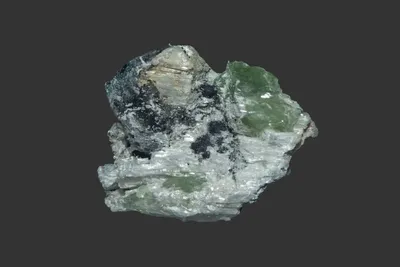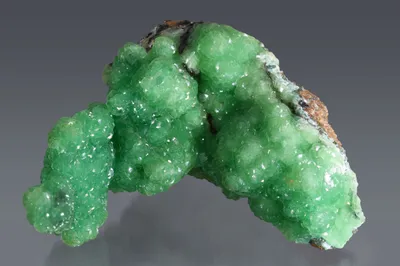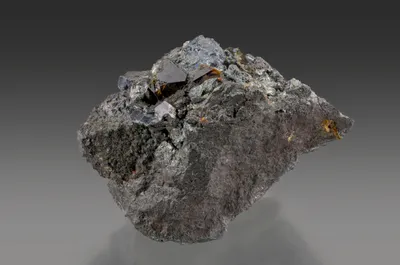
Image Credit: Malcolm Southwood
Mineral Species
Stottite
Type Locality
Yes
Composition
Fe2+Ge4+(OH)6
Crystal System
Tetragonal
Status at Tsumeb
Confirmed (type locality)
Abundance
Extremely rare
Distribution
Second oxidation zone
Paragenesis
Supergene
Entry Number
Species; TSNB334
Type Mineralogy
In 1957 a Tsumeb miner by the name of Friedrich Gramatzki, working on 30 Level in the second oxidation zone, found a specimen of tennantite-rich ore with two crystals of a mineral resembling siderite. He passed the specimen to Professor Hugo Strunz who was visiting Tsumeb at the time. It was from this specimen that Strunz et al. (1958a) described the new mineral stottite, naming it after Charles E. Stott (1896-1978), general manager of the Tsumeb Corporation Ltd between 1953 and 1965 and a keen supporter of mineralogical research. Stottite is an IMA-approved species with "grandfathered" status (http://cnmnc.units.it/; accessed January 2023). The structure of stottite was refined by Ross et al. (1988). Type material is conserved at the Institut für Mineralogie und Kristallographie, Technische Universität, Berlin (catalogue numbers 86/61 and 86/62) and at Ecole Nationale Supérieure des Mines, Musée de Minéralogie, Paris (catalogue number 51004).
General Notes
The type specimen of stottite is from 30 Level but subsequent discoveries were made in the 1960s, 70s, and 80s on levels 29, 30, and 31, essentially the middle portion of the second oxidation zone and a portion of the ore body with significant germanium enrichment.
Stottite occurs as individual pseudo-octahedral crystals or as anhedral masses rarely exceeding 10 mm; however, exceptionally, crystals of 20 mm have been found. Crystals are generally translucent and sometimes transparent. In transmitted light the mineral varies from nearly colorless (particularly in the cores of crystals) through green, yellow-brown, sherry-brown, to red, but in incident light most crystals appear medium brown to dark brown, with a resinous to adamantine lustre. The mineral shows good cleavage on {100} and {010} and poor cleavage on {001}, with cleaved surfaces displaying a greasy lustre.
The original analysis of stottite (Strunz et al. 1958a) showed the type material to contain 1.08 wt % MnO2 with < 0.5 wt % each for MgO and CaO. Geier and Ottemann (1970) analysed a specimen that they termed "Mineral A" and found it to have the stottite structure but with 12.6 wt % Zn and correspondingly less Fe; they proposed zincstottite as a varietal name. They also proposed that a second specimen "Mineral B" containing 23.2 wt % Mn, should be considered a manganese analogue of stottite, for which Bartelke (1976) later used the name mangan-stottite. The names zincstottite and mangan-stottite appear in some of the Tsumeb literature (for example, Bartelke 1976; Pinch and Wilson 1977) but are now considered obsolete.
Stottite was originally considered to be an iron germanate, but Ross et al. (1988) showed that its structure comprises alternating Fe(OH)6 and Ge(OH)6 octahedra in a corner-sharing, three-dimensional array so that, strictly speaking, it is an hydroxide of iron and germanium. They also noted that crystals of stottite commonly host minute inclusions of siderite, to which the zinc and manganese in some analyses may be at least partly attributable.
Keller (1977a) placed stottite in two of his "rare parageneses":
R/2: primary sulphides >> brunogeierite >> stottite >> smithsonite
R/3: quartz >> chalcocite >> schneiderhöhnite >> stottite
Cesbron et al. (1977) suggested that reinerite is also part of the same paragenesis. The close association of stottite with three, and perhaps four, zinc arsenites suggests that it forms under somewhat reducing conditions (Southwood, 2015).
Stottite is a very rare mineral readily confused with siderite, wulfenite, stolzite or (less commonly) powellite and scheelite. Analysis is required for certain identification.
Associated Minerals
brunogeierite; chalcocite; germanite; hematite; köttigite; krieselite; leiteite; ludlockite; molybdenite; plumbogummite; reinerite; renierite; schneiderhöhnite; siderite; smithsonite; tennantite-(Zn)




